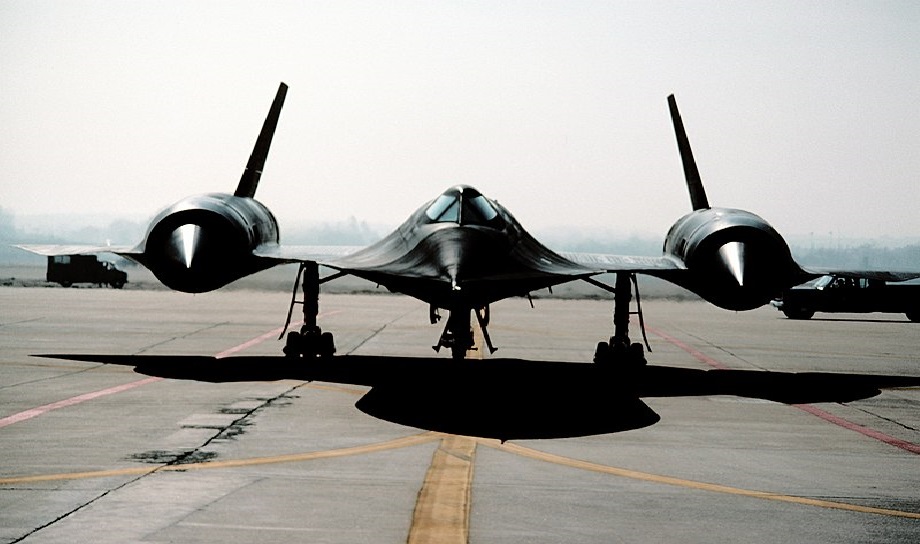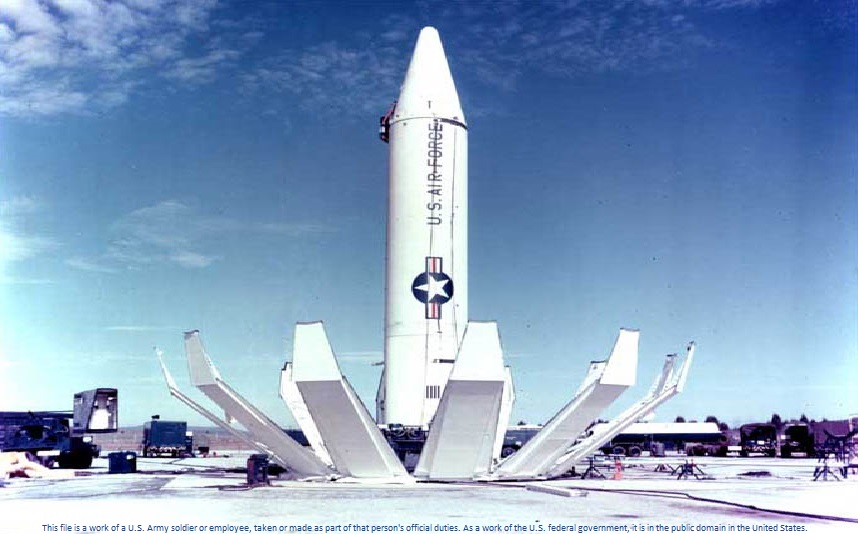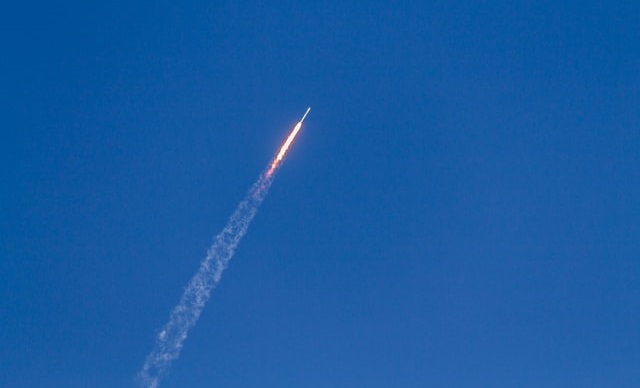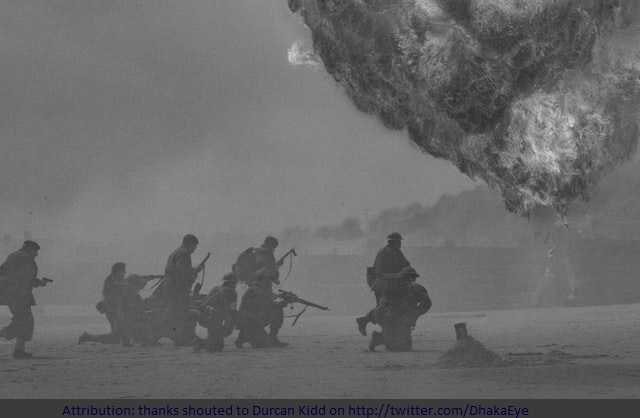During the Cuban Missile Crisis, the then Soviet Union and the United States went to the brink of a nuclear war, and finally resolved the issue on the negotiation board which can be explained by the concept of brinkmanship policy. The crisis began in October of 1962 when a U.S. U 2 reconnaissance aircraft was able to take pictures of missile sites in Cuba. This was during the Cold War between the United States and the Soviet Union, and the Cold War culminated through several events such as the construction of the Berlin Wall by the Soviet Union, and the US initiated covert operation on Cuba called the Bay of Pigs invasion[1] in order to overthrow the Cuban revolutionary Castro government. At that time, the USSR lagged behind the USA in terms of nuclear power. As nuclear weapons remain an essential part of the security policies of leading states,[2] the US deployed nuclear-capable forward-striking Jupiter missiles in Italy and Turkey in 1958 and 1959[3] on which the Soviet leadership had discomfort about the number of nuclear weapons in Western Europe and Turkey.[4] After the ‘Bay of Pigs Invasion,’ when Castro seek nuclear missiles to enhance Cuban security,[5] Khrushchev found if nuclear sites were established on this island, just 90 miles away from Florida, she would gain a balance of power against the USA. However, it was seen previously that diplomatic negotiations eventually led the two superpowers to resolve the crisis on the brink of a combat-ready American and Soviet tanks’ faceoff in Berlin[6]. The Cuban Missile Crisis reached a stage that can only be called brinkmanship which refers to pushing a dangerous situation to the brink of disaster before reaching a deal[7] and whoever backs down first is ultimately the loser.[8] And in this essay, it would be seen how, in order to achieve their own interests, the negotiators brought the situation to the edge, and how the gainer Kennedy brought the board according to his desire since, in the end, Khrushchev first agreed to the US president’s demand.

JFK with his advisory committee the ExComm[9] pursued to compel the USSR to admit to the US demand as an imperative that the Soviet missile constructions must be removed immediately. There were other options from other voices but they could not bring the US strategic victory in the Cuban crisis. With the stance that the US could simply ignore the Cuban missiles, Defense Secretary McNamara viewed that the USSR’s nuclear defense in Cuba would not significantly change the balance of Soviet power.[10] However, Kennedy needed a policy that would save the US from being humiliated and repel the USSR from Cuba along with all her missile installations. For him, the missile installations gave the Soviets an advantageous striking position over the US. But, strategically defeating the Soviets with brinkmanship would be the most beneficial before the US presidential election in 1963. Therefore, for him, the US needed to come to an offensive position at the onset; up to the edge of a nuclear war where the strategically nearest Cuban base would be under a winning target.

The other choices were rejected by Kennedy because those could make the US beaten. The ExComm thought of a military invasion followed by an airstrike on the missile sites in Cuba. Kennedy did not go for the airstrike because in his view any untouched missile in Cuba could be used in retaliation. Moreover, perhaps, Kennedy could have guessed with his prudence that there could be furthermore USSR soldiers than the given estimation of six to eight thousand to him.[11] On the other hand, the then-ambassador to the UN Stevenson recommended the action to remove missile installation from Cuba in exchange for the removal of Jupiter missiles from Italy and Turkey.[12] However, JFK did not like it as well; perhaps he assessed it as it could reflect a psychological weakness like justifying recognition of Castro’s revolutionary government if negotiations were the only tool rather than escalating the situation. Besides, if negotiations were the only tool, Khrushchev could advance Cuban missiles to an operational level by adopting a time-lapse plan.

The only remaining effective option for brinkmanship was to demonstrate the US military might with lethal seriousness as a means to frighten and intimidate the opponent block so that o the end they come to a deal. Therefore, combined US offensive and defensive capabilities were formed as essential in meeting the security requirements for a full range of military preparations and activities to reduce the threat posed by nuclear weapons and their associated delivery means.[13] And, it was seen that the US initiated a naval blockade, officially calling it ‘quarantine’ along with deploying a readied US invasion force nearing one hundred and fifty thousand troops in Florida. Additionally, Kennedy announced to the US citizens that his government understood the Soviet missiles’ clandestine construction in Cuba as for earning “a nuclear strike capability against the Western Hemisphere” and an “explicit threat to the peace and security of all the Americas”.[14] On policy seriousness, prior to referring to the Rio treaty, JFK clearly mentioned that any launching of a nuclear missile from Cuba to any country in the Western Hemisphere would be regarded as an attack from the USSR on the US necessitating a full retaliatory response upon the USSR.[15] For the climax, on top of the blockade, twenty-three nuclear-armed B-52 bombers were sent to orbit points within the striking distance of the Soviet Union.[16] Another risky technique to control the board of brinkmanship was that there was a tight reconnaissance system over Cuba to detect uneven postures in missile sites by the Soviets.[17]And, for defensive posture, a colossal naval line from the North coast of Venezuela to the South coast of Florida so that any Soviet naval shipments en route to Cuba did not dare to pursue assistance to missile construction development in Cuba. The US military commanders such as Admiral Robert L. Dennison, and Vice Admiral Alfred G. Ward deployed heavy military armaments targeting Cuba so that on one hand, readied Army, Air Force, Marine, and Navy assault can possibly invade Cuba, and on the other hand, air, naval gunfire, and amphibious strikes can be launched against Soviet submarines operating in the area and Cuban forces ashore.[18] As pointed out earlier, there was a highly risk-taking policy JFK took if any halted Russian ship or submarine before the US naval blockade would open fire against any US ship or tried to violate the blockade that would cause an immediate response from the US side resulting in an Armageddon.

It is likely that the shooting down of the US aircraft was preordered so that Khrushchev could escalate the situation. And, the Soviets were able to shoot down a US surveillance plane from the soil of Cuba on 27 October.[19] Yet, Khrushchev could not hold on to this portion of technical gain by making several other or further actions. On the other hand, there was scope for the Soviets to make several to an unknown number of missiles to operational level by 16 October. Otherwise, the US taking deterrence measures could not stop the Soviet plan. The Soviet experts failed to make full-scale preparation in a nutshell; so it indicates that rather they went to make the missiles operational with step-by-step logistical support by shipments through the sea which was instrumented by the US on the brinkmanship. A significant point is that the Soviets could have flawless clandestine installations and logistics for the missiles in Cuba. If the construction of the sites could be righteously veiled, the US could only come to know about the sites after they had become operational. In such conditions, once brinkmanship took place, it cannot be denied that Khrushchev could be the winner having an advantageous position.
At the climax of the US military readiness against the Soviet positions, Kennedy was able to turn Khrushchev to come on the path of deal for the solution to the grim situation. After attaining striking military readiness, on 22 October, he did not only provide a public speech but also sent a letter to Khrushchev with a strong voice on the US will and determination to respond heavily to the threat posed to her and her allies by the USSR. And after mentioning to Khrushchev that once a nuclear action is set off, no country was going to win except for catastrophic consequences for the entire world, and then, to the end, Kennedy threw his diplomatic offer for peaceful negotiation.[20] In the next subsequent letters, in countering Kennedy, Khrushchev failed to depict the Soviet as a striking power with an advantageous position such as falsely or truly telling that some or several missiles in Cuban sites had already become operational for carrying nuclear warheads. This negotiation technique of Khrushchev could make him control the negotiation board. But Khrushchev failed to do what could have been effective because it was seen in the last paragraph of President Kennedy’s letter on 27 October, where Kennedy emphasized the need to deactivate such weapons, meaning the United States had an idea that an unknown number of missiles had gone into operation. Though in his letter on 24 October, though Khrushchev made a combative voice in the first part, later, he showed an undermining tone instead of an offensive expression on his Cuban site’s colossal status; operational level of a number of missiles. Rather he indicated that missiles were deterrents in nature, and even, submissively expressed that they were on peaceful intentions.[21] A significant weakness of Khrushchev on the board was that he failed to threaten his rival by bringing his most important ally Castro who could not only hold on to Khrushchev’s points on the verge of fall but also could create pressure on his rival by saying to bring the issue of “quarantine” to the UN which was actually a blockade; an act of war under international law,[22] and above all, a violation of the sovereignty of his nation. On 24 October’s letter, Khrushchev, being quite passive, did not mention his saying “International law exists and universally recognized norms of conduct exist”.[23] When Kennedy’s letter on 22 October was concise with concrete objective, Khrushchev’s letter on 24 October was longer, somewhat subjective, and lacked consistency in determination, rigidity, and will since he said, “I am convinced that in my place you would act the same way”.[24] Further weakness Khrushchev made was that he failed to demand two things in one single letter i.e. demand to never invade Cuba on 26 October letter,[25] and remove US missiles from Turkey in the next day’s letter[26] which Kennedy instrumented by disregarding in the following response.[27]It was Khrushchev who bowed down at first by telling the Soviets’ willingness to remove the colossal strategic Cuban project in his rambling letter on 27 October[28]; and the following morning, issued a public statement on dismantling and removal of the Cuban sites.[29]

The resolution of the Cuban Crisis paved the way for a peaceful future of the world, most notably the atmospheric and underwater nuclear test ban treaty signed in 1963 by the US, the USSR, and the UK.[30] As a backdoor trade with the Soviets associated with the resolution, subsequently, nuclear-capable Jupiter missiles were also removed from Turkey.[31] The resolution and subsequent test ban treaty of 1963 prove non-proliferation because the complete dismantling of Cuban missile sites shows the active progress of nuclear disarmament and curbing the spread of nuclear arms with the presence of efficient regimes.[32] Though both the US and the USSR started with confrontational messages against each other on the brinkmanship there was mutual fear which led to a shared value: the need for survival in the face of possible annihilation.[33] It led to agreeing on each other’s strategic proposals which Khrushchev responded to at first. However, the US’s deals to never invade Cuba and the assurance to remove missiles from Turkey played roles to save the Soviets from widespread humiliation.
Footnotes:
[1] “Bay of Pigs Invasion,” history.com, last modified March 30, 2020, Para 1, https://www.history.com/topics/cold-war/bay-of-pigs-invasion. [Accessed 03 April, 2022]
[2] Morten Bremer Mærli and Sverre Lodgaard, ‘Nuclear Proliferation and International Security,’ Routledge global security studies [Routledge Tailor & Francis Gropu, London and New York: 2007]
[3] Missile Defense Project, “SM-78 Jupiter,” Centre for Strategic and International Studies, Last Modified May 18, 2021, Para 10, https://missilethreat.csis.org/missile/jupiter/ . Accessed 07 April, 2022
[4] “Cuban Missile Crisis,” history.com, Last Modified October 22, 2021, Para 6, https://www.history.com/topics/cold-war/cuban-missile-crisis. [Accessed 07 April, 2022]
[5] Morten Bremer Mærli and Sverre Lodgaard, ‘Nuclear Proliferation and International Security,’ Routledge global security studies, [Routledge Tailor & Francis Gropu, London and New York: 2007]: 5 and 27
[6] Standoff in Berlin”, army.mil, https://www.army.mil/article/46993/standoff_in_berlin_october_1961 . [Accessed 02 April, 2022]
[7] “Brinkmanship: Definition & Policy,” study.com, https://study.com/academy/lesson/brinkmanship-definition-policy.html. [Accessed 15 February, 2022]
[8] Ibid.
[9] “Cuban Missile Crisis,” history.com, Para 4
[10] Timothy Naftali and Philip Zelikow, “MEETING ON THE CUBAN MISSILE CRISIS ON 16 OCTOBER 1962”, TRANSCRIPT in Presidential Recordings Digital Edition, Miller Centre, University of Virginia, https://prde.upress.virginia.edu/conversations/8020045. [Accessed 28 March, 2022]
[11] In fact, there were about 40,000 Soviet soldiers stationed in Cuba. Christopher Klein, “10 Things You May Not Know About the Cuban Missile Crisis”, History Stories, histroy.com, Last Modified September 01, 2018, see: https://www.history.com/news/10-things-you-may-not-know-about-the-cuban-missile-crisis. [Accessed 03 April, 2022]
[12] Michael Dobbs, “The Day Adlai Stevenson Showed ‘Em at the U.N.”, The Washington Post, February 5, 2003, https://www.washingtonpost.com/archive/lifestyle/2003/02/05/the-day-adlai-stevenson-showed-em-at-the-un/24420f12-5f7a-4f2d-b91e-2b84e04ee6ab/. [Accessed March 29, 2022]
[13] Morten Bremer Mærli and Sverre Lodgaard, ‘Nuclear Proliferation and International Security,’ Routledge global security studies [Routledge Tailor & Francis Gropu, London and New York: 2007]: 04 and 27
[14] “President John F. Kennedy’s Speech Announcing the Quarantine against Cuba, October 22, 1962”, [Washington: 22 October 1962], Para 01 and 05, https://www.mtholyoke.edu/acad/intrel/kencuba.htm. [Accessed 03 April, 2022]
[15] Ibid. Para 18 and 17.
[17] So, it was seen in the ExComm meeting that the US leaders on 16 October talked about two high-altitude U-2s, and five lesser-altitude U-2s over Cuba. See: Naftali, “MEETING ON THE CUBAN MISSILE CRISIS”
[18] “Cuban Missile Crisis”, Naval History and Heritage Command, Naval History and Heritage, Last Modified August 13, 2020, https://www.history.navy.mil/browse-by-topic/wars-conflicts-and-operations/cuban-missile.html. [Accessed 08 April, 2022]
[19] “Cuban Missile Crisis,” history.com, Para 8
[20] “Cuban Missle Crisis: Letter From President Kennedy to Chairman Khrushchev,” Yale Law School [Lillian Goldman Law Library, Washington: October 22, 1962], https://avalon.law.yale.edu/20th_century/msc_cuba044.asp
[21] “Chairman Khrushchev’s Letter to President Kennedy”, October 23, 1962, Division of Language Services, Department of State, Para 05, https://microsites.jfklibrary.org/cmc/oct23/doc6.html. [Accessed April 03, 2022]
[22] “Blockade”, The Practical Guide to Humanitarian Law, Médecins Sans Frontières, https://guide-humanitarian-law.org/content/article/3/blockade/. [Accessed March 30, 2022]
[23] “Letter From Chairman Khrushchev to President Kennedy”, October 24, 1962, Mount Holyoke College, mtholyoke.edu, Para 06, https://www.mtholyoke.edu/acad/intrel/nikita.htm. April 02, 2022
[25] “KHRUSHCHEV’S LETTER TO KENNEDY ON CUBA (1962)”, On the evening of October 26th, 1962, alpha history, https://alphahistory.com/coldwar/khrushchevs-letter-to-kennedy-on-cuba-1962/
[26] “Cuban Missile Crisis: Chairman Khrushchev’s Letter to President Kennedy”, October 27, 1962, Database of Japanese Politics and International Relations, The University of Tokyo, Para 04, https://worldjpn.grips.ac.jp/documents/texts/docs/19621027.O1E.html. [Accessed April 03, 2022]
[27] “Letter From Chairman”, October 24, 1962, Para 5
[28] Letter from John Kennedy to Nikita Khrushchev”, October 27, 1962, Digital History, https://www.digitalhistory.uh.edu/disp_textbook.cfm?smtID=3&psid=3637. [Accessed 02 April, 2022]
[29] “Cuban Missile Crisis”, October 27, 1962, Database of Japanese
[30] Office of the Historian, “The Cuban Missile Crisis, October 1962″, Department of State, https://history.state.gov/milestones/1961-1968/cuban-missile-crisis. [Accessed 02 April, 2022]
[31] “NUCLEAR TEST BAN TREATY”, John F. Kennedy Presidential Library and Museum, https://www.jfklibrary.org/learn/about-jfk/jfk-in-history/nuclear-test-ban-treaty. [Accessed 07 April, 2022]
[32] Missile Defense, “SM-78 Jupiter,” Para 09
[33] Bremer, ‘Nuclear Proliferation,’ 3
[34] Starkey, B. Boyer, M. & Wilkenfeld, J., International Negotiation in a Complex World, Links to an external site, 4th ed. (London, Rowman & Littlefield: 2015), 54
Bibliography:
“10 Things You May Not Know About the Cuban Missile Crisis”, History Stories, histroy.com,
Last Modified September 01, 2018, See: https://www.history.com/news/10-things-you-
may-not-know-about-the-cuban-missile-crisis. [Accessed 03 April, 2022]
Alpha History, “KHRUSHCHEV’S LETTER TO KENNEDY ON CUBA (1962)”, On the
evening of October 26th, 1962, https://alphahistory.com/coldwar/khrushchevs-letter-to-
kennedy-on-cuba-1962/
“Bay of Pigs Invasion,” history.com, last modified March 30, 2020,
https://www.history.com/topics/cold-war/bay-of-pigs-invasion. [Accessed 03 April,
2022]
“Blockade”, The Practical Guide to Humanitarian Law, Médecins Sans Frontières, https://guide-
humanitarian-law.org/content/article/3/blockade/. [Accessed March 30, 2022]
Boyer, Starkey B., M. & Wilkenfeld, J., International Negotiation in a Complex World, Links
to an external site, 4th ed. (London, Rowman & Littlefield: 2015)
“Brinkmanship: Definition & Policy,” study.com,
https://study.com/academy/lesson/brinkmanship-definition-policy.html. [Accessed 15
February 2022]
Digital History, “Letter from John Kennedy to Nikita Khrushchev”, October 27, 1962,
https://www.digitalhistory.uh.edu/disp_textbook.cfm?smtID=3&psid=3637. [Accessed
02 April, 2022]
Dobbs, Michael, “The Day Adlai Stevenson Showed ‘Em at the U.N.”, The Washington Post,
February 5, 2003, https://www.washingtonpost.com/archive/lifestyle/2003/02/05/the-
day-adlai-stevenson-showed-em-at-the-un/24420f12-5f7a-4f2d-b91e-2b84e04ee6ab/.
[Accessed March 29, 2022]
Mærli, Morten Bremer, and Sverre Lodgaard, ‘Nuclear Proliferation and International Security,’
Routledge global security studies [Routledge Tailor & Francis Gropu, London and New
York: 2007]
Missile Defense Project, “SM-78 Jupiter,” Centre for Strategic and International Studies, Last
Modified May 18, 2021, https://missilethreat.csis.org/missile/jupiter/. Accessed 07 April,
2022
Modern International Relations: Basic Documents, “Cuban Missile Crisis: Chairman
Khrushchev’s Letter to President Kennedy”, October 27, 1962, Database of Japanese
Naftali, Timothy, and Philip Zelikow, “MEETING ON THE CUBAN MISSILE CRISIS ON 16
OCTOBER 1962″, TRANSCRIPT in Presidential Recordings Digital Edition, Miller
Centre, University of Virginia, https://prde.upress.virginia.edu/conversations/8020045.
[Accessed 28 March 2022]
National Archive, “Cuban Missile Crisis: Letter from President Kennedy to Chairman
Khrushchev,” Yale Law School [Lillian Goldman Law Library, Washington: October 22,
1962], https://avalon.law.yale.edu/20th_century/msc_cuba044.asp
National Archive, “Cuban Missile Crisis,” A&E Television Networks, history.com, Last
Modified October 22, 2021, https://www.history.com/topics/cold-war/cuban-missile-
crisis. [Accessed 07 April, 2022]
Naval History and Heritage Command, “Cuban Missile Crisis” [Naval History and Heritage:
August 13, 2020], https://www.history.navy.mil/browse-by-topic/wars-conflicts-
and-operations/cuban-missile.html. [Accessed 08 April, 2022]
“NUCLEAR TEST BAN TREATY”, John F. Kennedy Presidential Library and Museum,
https://www.jfklibrary.org/learn/about-jfk/jfk-in-history/nuclear-test-ban-treaty.
[Accessed 07 April, 2022]
Office of the Historian, “The Cuban Missile Crisis, October 1962″, Department of State,
https://history.state.gov/milestones/1961-1968/cuban-missile-crisis. [Accessed 02 April,
2022]
Politics and International Relations, The University of Tokyo, Para 04,
https://worldjpn.grips.ac.jp/documents/texts/docs/19621027.O1E.html. [Accessed 03
April, 2022]
Standoff in Berlin”, army.mil,
https://www.army.mil/article/46993/standoff_in_berlin_october_1961 . [Accessed 02
April, 2022]
U.S. Department of State, “Chairman Khrushchev’s Letter to President Kennedy”, October 23,
1962, Division of Language Services,
https://microsites.jfklibrary.org/cmc/oct23/doc6.html. [Accessed 03 April, 2022]
U.S. Department of State, “Letter from Chairman Khrushchev to President Kennedy”,
October 24, 1962, Mount Holyoke College, mtholyoke.edu,
https://www.mtholyoke.edu/acad/intrel/nikita.htm. [Accessed 02 April, 2022]
U.S. Department of State, “President John F. Kennedy’s Speech Announcing the Quarantine
against Cuba, Mount Holyoke College, mtholyoke.edu, October 22, 1962”,
[Washington: 22 October 1962], https://www.mtholyoke.edu/acad/intrel/kencuba.htm.
[Accessed 07 April, 2022]


